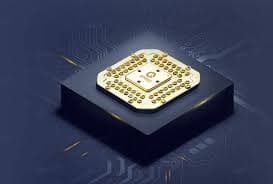
Quantum Chips: The Brains Behind the Next Tech Revolution
Quantum chips are at the forefront of a technological revolution, poised to redefine computing as we know it. Unlike traditional chips that process bits in a binary fashion (0s and 1s), quantum chips utilize qubits—quantum bits that can exist in multiple states simultaneously, thanks to the principles of superposition and entanglement. This allows quantum computers to perform complex calculations at unprecedented speeds, tackling problems that are currently intractable for classical computers.
What Exactly Is a Quantum Chip?
At its core, a quantum chip is the processor of a quantum computer, designed to manipulate and maintain qubits. These qubits can be realized using various physical systems, such as superconducting circuits, trapped ions, or photons. The choice of qubit implementation affects the chip's performance, scalability, and error rates. (What Is a Quantum Chip and How It Works: The Ultimate Guide)
One of the significant challenges in quantum computing is maintaining qubit coherence—keeping qubits in their quantum state long enough to perform calculations. Quantum chips are engineered with intricate control systems and error correction mechanisms to address this issue.
Recent Milestones in Quantum Chip Development
The race to build practical quantum computers has led to remarkable advancements in quantum chip technology:
- Google's Willow Chip: This chip achieved a computation in under five minutes that would take a classical supercomputer 10 septillion years, showcasing the immense potential of quantum processing. (Meet Willow, our state-of-the-art quantum chip - Google Blog)
- Microsoft's Majorana 1: Introducing a topological qubit architecture, this chip uses Majorana quasiparticles to create qubits that are inherently resistant to errors, paving the way for more stable quantum computations. (Microsoft Azure Quantum)
- IBM's Heron R2 Processor: A significant step towards fault-tolerant quantum computing, this processor aims to enhance the scalability and reliability of quantum systems.
These developments signify a transition from theoretical research to practical applications, bringing us closer to the era of quantum advantage.
Real-World Applications on the Horizon
Quantum chips hold the promise to revolutionize various industries:
- Healthcare: Accelerating drug discovery by simulating molecular interactions at a quantum level. (Big Tech has officially entered its quantum era — here's what it means for the industry)
- Finance: Optimizing complex financial models and risk assessments.
- Artificial Intelligence: Enhancing machine learning algorithms through faster data processing.
- Cybersecurity: Developing quantum encryption methods to secure communications against future threats. (Secure 'quantum messages' sent over telecoms network in breakthrough)
These applications are not just theoretical; companies and research institutions are actively exploring quantum solutions to address real-world challenges.
The Road Ahead
While the progress is impressive, several hurdles remain:
- Scalability: Building quantum chips with a higher number of qubits without compromising stability.
- Error Correction: Developing more efficient methods to detect and correct errors in quantum computations. (Meet Willow, our state-of-the-art quantum chip - Google Blog)
- Integration: Combining quantum chips with existing classical systems for hybrid computing solutions. (The Complete Guide to Quantum Chips - AnySilicon)
Addressing these challenges requires collaborative efforts across disciplines, including physics, engineering, and computer science.
Conclusion
Quantum chips represent a monumental leap in computing technology, offering solutions to problems once deemed unsolvable. As research and development continue to advance, we edge closer to a future where quantum computing becomes an integral part of our technological landscape. For those passionate about innovation, this is an exciting frontier filled with opportunities to shape the next era of computing.